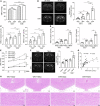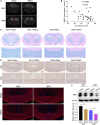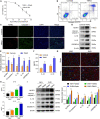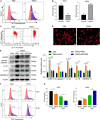Trimethylamine N-oxide promotes demyelination in spontaneous hypertension rats through enhancing pyroptosis of oligodendrocytes
- PMID: 36072486
- PMCID: PMC9441869
- DOI: 10.3389/fnagi.2022.963876
Trimethylamine N-oxide promotes demyelination in spontaneous hypertension rats through enhancing pyroptosis of oligodendrocytes
Abstract
Background: Hypertension is a leading risk factor for cerebral small vessel disease (CSVD), a brain microvessels dysfunction accompanied by white matter lesions (WML). Trimethylamine N-oxide (TMAO), a metabolite of intestinal flora, is correlated with cardiovascular and aging diseases. Here, we explored the effect of TMAO on the demyelination of WML.
Methods: Spontaneous hypertension rats (SHRs) and primary oligodendrocytes were used to explore the effect of TMAO on demyelination in vivo and in vitro. T2-weighted magnetic resonance imaging (MRI) was applied to characterize the white matter hyperintensities (WMH) in rats. TMAO level was evaluated using LC-MS/MS assay. The histopathological changes of corpus callosum were measured by hematoxylin-eosin and luxol fast blue staining. And the related markers were detected by IHC, IF and western blot assay. Mito Tracker Red probe, DCFH-DA assay, flow cytometry based on JC-1 staining and Annexin V-FITC/PI double staining were conducted to evaluate the mitochondrial function, intracellular ROS levels and cell apoptosis.
Results: SHRs exhibited stronger WMH signals and a higher TMAO level than age-matched normotensive Wistar-kyoto rats (WKY). The corpus callosum region of SHR showed decreased volumes and enhanced demyelination when treated with TMAO. Furthermore, TMAO significantly elevated ROS production and induced NLRP3 inflammasome and impairment of mitochondrial function of oligodendrocytes. More importantly, TMAO enhanced the pyroptosis-related inflammatory death of oligodendrocytes.
Conclusion: TMAO could cross the blood-brain barrier (BBB) and promote oligodendrocytes pyroptosis via ROS/NLRP3 inflammasome signaling and mitochondrial dysfunction to promote demyelination, revealing a new diagnostic marker for WML under hypertension.
Keywords: demyelination; hypertension; pyroptosis; trimethylamine N-oxide; white matter lesions.
Copyright © 2022 Ji, Tian, Niu, Yao and Qu.
Conflict of interest statement
The authors declare that the research was conducted in the absence of any commercial or financial relationships that could be construed as a potential conflict of interest.
Figures




Similar articles
-
Trimethylamine N-oxide induces pyroptosis in HTR8-S/Vneo cells through the ten-eleven translocation 2-cytochrome b-reactive oxygen species pathway.J Obstet Gynaecol Res. 2025 Feb;51(2):e16237. doi: 10.1111/jog.16237. J Obstet Gynaecol Res. 2025. PMID: 39957440
-
Chronic, low-dose TMAO treatment reduces diastolic dysfunction and heart fibrosis in hypertensive rats.Am J Physiol Heart Circ Physiol. 2018 Dec 1;315(6):H1805-H1820. doi: 10.1152/ajpheart.00536.2018. Epub 2018 Sep 28. Am J Physiol Heart Circ Physiol. 2018. PMID: 30265149
-
Trimethylamine-N-Oxide Promotes High-Glucose-Induced Dysfunction and NLRP3 Inflammasome Activation in Retinal Microvascular Endothelial Cells.J Ophthalmol. 2023 Feb 28;2023:8224752. doi: 10.1155/2023/8224752. eCollection 2023. J Ophthalmol. 2023. PMID: 36895266 Free PMC article.
-
Trimethylamine-N-Oxide Pathway: A Potential Target for the Treatment of MAFLD.Front Mol Biosci. 2021 Oct 1;8:733507. doi: 10.3389/fmolb.2021.733507. eCollection 2021. Front Mol Biosci. 2021. PMID: 34660695 Free PMC article. Review.
-
Trimethylamine N-oxide: A harmful, protective or diagnostic marker in lifestyle diseases?Nutrition. 2018 Feb;46:7-12. doi: 10.1016/j.nut.2017.08.001. Epub 2017 Aug 7. Nutrition. 2018. PMID: 29290360 Review.
Cited by
-
The Role of Gut Microbiota in Blood-Brain Barrier Disruption after Stroke.Mol Neurobiol. 2024 Dec;61(12):9735-9755. doi: 10.1007/s12035-023-03512-7. Epub 2023 Jul 27. Mol Neurobiol. 2024. PMID: 37498481 Review.
-
Gut Microbe-Generated Metabolite Trimethylamine-N-Oxide and Ischemic Stroke.Biomolecules. 2024 Nov 18;14(11):1463. doi: 10.3390/biom14111463. Biomolecules. 2024. PMID: 39595639 Free PMC article. Review.
-
Assessment of blood-brain barrier injury in hypertensive CSVD by 11.7TMR T1mapping and microvascular pathologic changes.Metab Brain Dis. 2024 Dec 16;40(1):66. doi: 10.1007/s11011-024-01483-9. Metab Brain Dis. 2024. PMID: 39680228
-
Decoding TMAO in the Gut-Organ Axis: From Biomarkers and Cell Death Mechanisms to Therapeutic Horizons.Drug Des Devel Ther. 2025 Apr 29;19:3363-3393. doi: 10.2147/DDDT.S512207. eCollection 2025. Drug Des Devel Ther. 2025. PMID: 40322030 Free PMC article. Review.
-
Association between plasma trimethylamine N-oxide and cerebral white matter hyperintensity: a cross-sectional study.Front Aging Neurosci. 2024 Dec 4;16:1498502. doi: 10.3389/fnagi.2024.1498502. eCollection 2024. Front Aging Neurosci. 2024. PMID: 39697484 Free PMC article.
References
-
- Brunt V. E., LaRocca T. J., Bazzoni A. E., Sapinsley Z. J., Miyamoto-Ditmon J., Gioscia-Ryan R. A., et al. (2021). “The gut microbiome-derived metabolite trimethylamine N-oxide modulates neuroinflammation and cognitive function with aging.”. Geroscience 43 377–94. 10.1007/s11357-020-00257-2 - DOI - PMC - PubMed
LinkOut - more resources
Full Text Sources
Research Materials
Miscellaneous

